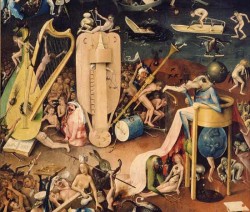
Hammerstein 1974
“Das musikalische Pandämonium des Hieronymus Bosch” (Reinhold Hammerstein) 1974
[in: Reinhold Hammerstein, Diabolus in Musica: Studien zur Ikonographie der Musik im Mittelalter. Neue Heidelberger Studien zur Musikwissenschaft – vol. 6, Francke, Bern-Munich, 1974, pp. 94-119]
[Also mentioned in Gibson 1983: 57-58 (D68)]
Hammerstein first refers to De Mirimonde 1971. He thinks it is an excellent article, but adds that the French author only associates the music in Bosch’s oeuvre with the idea of sinfulness and especially with the idea of Luxuria, thereby ignoring other aspects. According to Hammerstein De Mirimonde does not pay enough attention to the tradition in which Bosch’s musical scenes can be placed.
After having analyzed these musical scenes Hammerstein concludes that music with Bosch is continuously associated with sin and punishment (indeed very often in a context of unchastity). ‘Heavenly’ music is almost absent in his works, but ‘diabolical, infernal’ music, a perverted parody on heavenly music, is represented all the more. Furthermore earthly music rather has diabolical than heavenly connotations with Bosch.
The performers of ‘diabolical music’ are in most cases devils, but often also minstrels (the ministri Satanae on earth) and musicians who are being misled by the deceptive beauty of earthly sounds (for instance the group on top of the haywain). When depicting instruments (only a few, such as the violin and the organ, do not appear) Bosch often uses traditional means with a topical character: perverting alienation that leads to surrealistic effects (two instruments are molded together, instruments are part of a living being…), instruments that are intentionally being played in a wrong way and gigantic enlargement. New are Bosch’s extremely meticulous realism when depicting details or parts of instruments and the fact that he is appealed by fantastic, weird combinations.
[explicit]